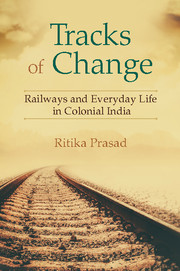Book contents
- Frontmatter
- Dedication
- Contents
- List of Tables and Figures
- Acknowledgements
- List of Abbreviations
- Introduction
- 1 The Nature of the Beast? An Elementary Logic for Third-Class Travel
- 2 Demand and Supply? Railway Space and Social Taxonomy
- 3 Crime and Punishment: In the Shadow of Railway Embankments
- 4 Railway Time: Speed, Synchronization, and ‘Time-Sense’
- 5 Contagion and Control: Managing Disease, Epidemics, and Mobility
- 6 Designing Rule: Power, Efficiency, and Anxiety
- 7 Marking Citizen from Denizen: Dissent, ‘Rogues,’ and Rupture
- Conclusion
- Bibliography
- Index
- About the Author
6 - Designing Rule: Power, Efficiency, and Anxiety
Published online by Cambridge University Press: 05 September 2015
- Frontmatter
- Dedication
- Contents
- List of Tables and Figures
- Acknowledgements
- List of Abbreviations
- Introduction
- 1 The Nature of the Beast? An Elementary Logic for Third-Class Travel
- 2 Demand and Supply? Railway Space and Social Taxonomy
- 3 Crime and Punishment: In the Shadow of Railway Embankments
- 4 Railway Time: Speed, Synchronization, and ‘Time-Sense’
- 5 Contagion and Control: Managing Disease, Epidemics, and Mobility
- 6 Designing Rule: Power, Efficiency, and Anxiety
- 7 Marking Citizen from Denizen: Dissent, ‘Rogues,’ and Rupture
- Conclusion
- Bibliography
- Index
- About the Author
Summary
In 1942, a press communiqué titled ‘National Importance of Travelling Less’ asked the Indian public to help the war effort by eschewing train travel. At the same time, a ‘Travel Less’ broadcast at Bombay's Regal cinema threw up a drawing of Shivaji on horseback, followed by the exhortation: ‘Shivaji rode a horse: why travel by train.’ An advertising consultant to the Railway Board explained that this publicity was meant to ensure that railways would not be ‘cluttered up with unimportant passenger traffic’ during wartime. The ensuing ‘Discourage Travel’ campaign reminded people of how Shivaji's horse and Shah Jehan's elephant used to be ‘good enough’ means of travel. However, as the campaign spread, some in the Railway Board became concerned about the political implications of such images—whether of the Maratha leader or of the Mughal emperor—as well as the dangers of creating ‘an anti-railway sense’ and suggested that passenger traffic be discouraged only until ‘normal’ conditions returned.
Almost a century before the ‘Discourage Travel’ campaign, the newly minted prospectus of the (provisionally registered) Great Bombay, Baroda, Cawnpore, and Lucknow railway company had emphasized the ‘incalculable’ military importance of railways lines to the imperial state. Like other firms hoping to attract official support for their commercial plans to construct railways in British India—including governmental guarantee on investment—they were quick to highlight the potential of railways to swiftly convey troops as well as luggage, stores, artillery, and other ‘cumbrous materials’ that attended a march, enable the government to distribute its forces strategically, and facilitate rapid concentration of troops.
No state, imperial or not, was oblivious to the strategic value of railways. Thus, while commercial concerns were important, military ones remained critical in planning and building. L.C.A. Knowles highlights the strategic concerns that informed the planning of French and German railways, also pointing out that some lines, such as those of Prussia with the Russian frontier, ‘would never have been built if the motive had been purely financial.’
- Type
- Chapter
- Information
- Tracks of ChangeRailways and Everyday Life in Colonial India, pp. 200 - 233Publisher: Cambridge University PressPrint publication year: 2015

